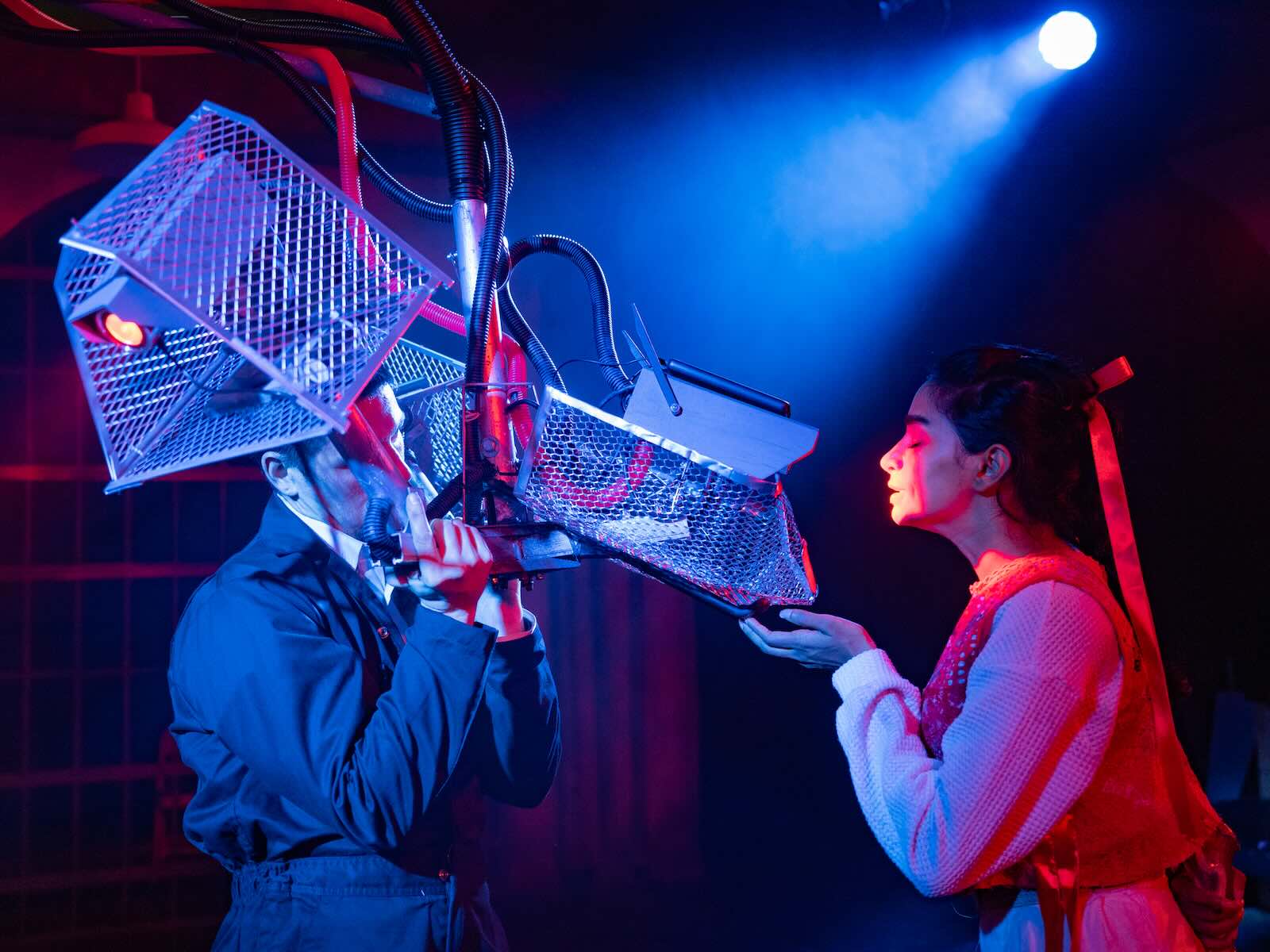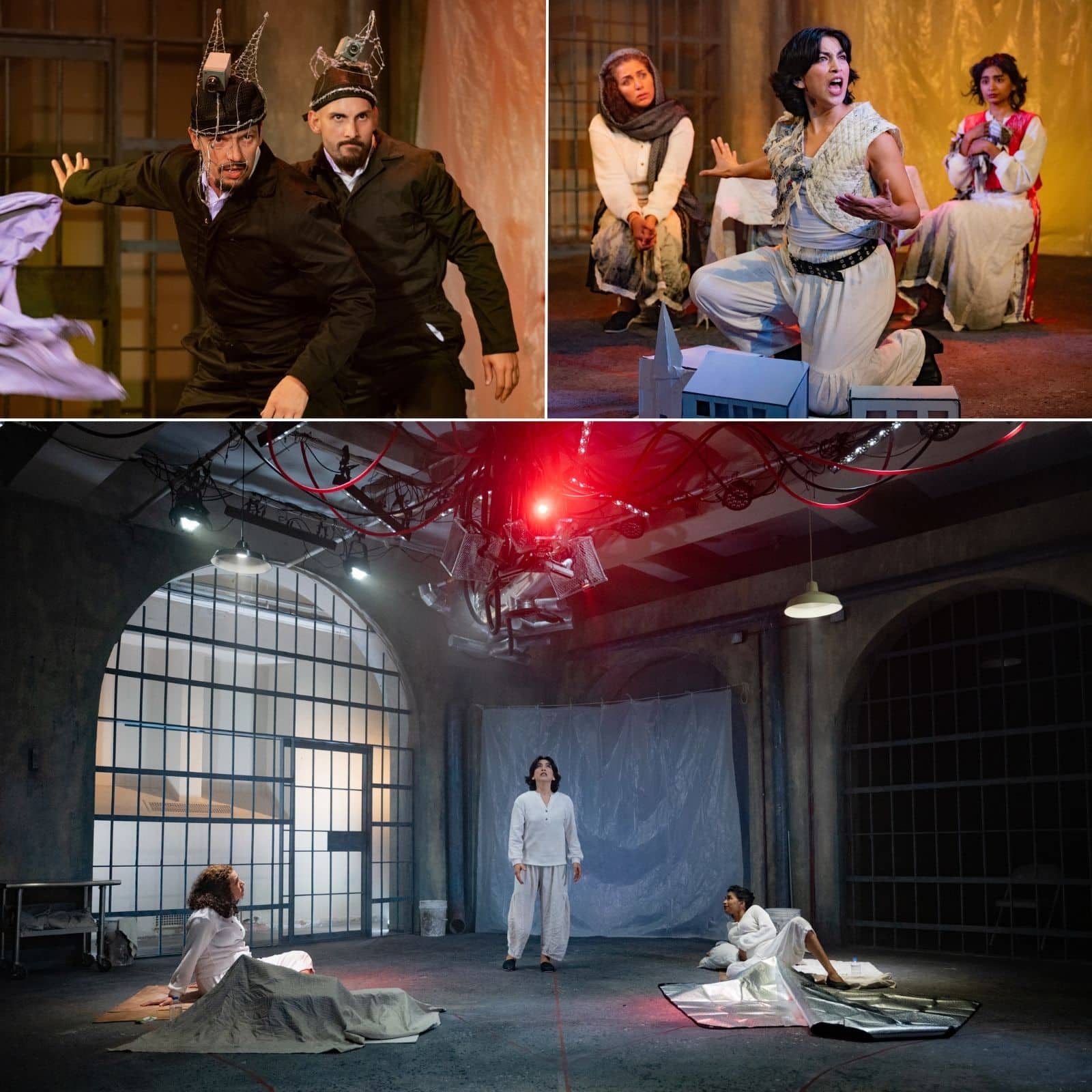What kind of play would be banned in both Stalinist Russia and Nazi Germany? Only one that dares to expose authoritarianism through the most accessible form: a children’s fairytale. The Dragon is just that — a political fairytale whose sharp satire, with unmistakable allusions to both Nazi Germany and Stalinist Russia (and now Ukraine and many others), earned it a ban in its own time, yet its warnings echo far beyond its era.
Originally written in the 1940s by Soviet playwright Evgeny Shvarts, a children’s author who adapted classics like The Snow Queen for stage and screen, The Dragon now returns in a bold new adaptation from Spooky Action Theater. This version is adapted and translated by Jesse Rasmussen (Professor Worland’s Black Magic Rock Show) and Yura Kordonsky (chair of directing at Yale School of Drama). Directed by Elizabeth Dinkova, Spooky Action’s artistic director, the production underscores the play’s enduring resonance, drawing connections to the stark realities of migrant detention centers in the U.S.

We begin inside a detention facility, where three women are held under the watch of two men in black vests. One of the women is pregnant, and in an effort to ease her pain, the other two transport her into a fairytale world. However, this fantastical land, while cloaked in magic and heroism, is not so different from the dystopian reality of the facility itself.
The tale unfolds as a reimagining of the classic Shvarts story, reshaped to reflect the present moment and the unique identities of the five actors. In this land, a town is ruled by an all-powerful dragon, who plans to kill a young girl, Elsa (Surasree Das), as his tribute. Lancelot (Fran Tapia), a young knight, arrives and boldly declares that he will slay the dragon. The dragon accepts a duel, the outcome of which will decide not only the future of the land but also who will rise as its next leader, raising the question: Is the new ruler any better than the dragon?
The town is populated by Isabella, Elsa’s mother (Raghad Makhlouf); the Mayor (Ryan Sellers); and his son Henry, Elsa’s betrothed (Gabriel Alejandro). After the battle, as Lancelot vanishes and Elsa’s marriage approaches, the borders between 2025 and the fairytale realm blur, until it becomes impossible to tell which time, or which world, we are inhabiting; what remains is a haunting reflection of our own.

Each actor plays multiple roles throughout the production and expertly transforms through physical and vocal changes. Tapia as the fierce hero, Lancelot; Makhlouf as the tender mother, Isabella; Alejandro as the sly secretary, Henry; Sellers as the deceitful mayor; and Das as the tragic heroine, Elsa.
Sellers and Alejandro also join forces to bring the infamous dragon to life: a three-headed, two-bodied creature animated through synchronized movement (choreography by Robert Bowen Smith). Set pieces form its heads, while layered voices give it speech (puppet design by Johnna Presby, sound design by Brandon Cook).
The cool cement arches of the Universalist National Memorial Church on 16th Street (Spooky Action’s home base) were fitted with metal bars, sometimes locking actors in, sometimes shutting them out (scenic design by Margarita Syrocheva). A striking juxtaposition of color defines Johnna Presby’s costume design: the white uniforms of the detention center against the black-vested guards, and the vivid red of a wedding gown mirrored in blood-stained pants. The production made ingenious use of recycled props, costumes, and set pieces that shifted seamlessly between the detention facility and Shvarts’ fairytale world.
Suspended at the center of the stage, three video cameras blink with red lights — surveillance tools in the migrant facility, dragon’s eyes in the fantasy (lighting design by Mike Durst). In both realities, their unblinking gaze reminds us: these characters are always being watched.
As director Elizabeth Dinkova said in her opening night speech: “In the face of adversity, we will do what we do best: we will connect, we will take care of each other, and we will not be afraid.” The Dragon is an ensemble-driven, physically stylized play that serves as both a reflection and commentary on the urgent issues facing 2025 America. True to its reputation for groundbreaking and daring theater, Spooky Action opens its 21st season, Counter Narratives, with this timely and provocative work: a play that centers the voices of those most affected and shares their stories with audiences of every kind.
As Shvarts’ fairytale reminds us, the danger of authoritarianism is not confined to any one time or place. Spooky Action’s adaptation makes it clear: the dragon is never as far away as we’d like to believe.
Running Time: Two hours, including one 15-minute intermission.
The Dragon plays through October 19, 2025, presented by Spooky Action Theater performing at the Universalist National Memorial Church, 1810 16th St NW, Washington, DC. Purchase tickets online (general admission, $43; students and industry, $23; seniors, $38). A limited number of economy tickets (6) are available at $17 online for all performances. The venue is currently not wheelchair accessible.
The program is online here.
COVID Safety: The performance on Thursday, October 9, at 7:30 pm. is mask-required.
The Dragon
By Evgeny Shvarts
Translated & Adapted by Jesse Rasmussen & Yura Kordonsky
Directed by Elizabeth Dinkova
CAST
Gabriel Alejandro: Luis/Henry
Surasree Das: Diya/Elsa
Raghad Makhlouf: Lina/Isabella
Ryan Sellers: Adam/Mayor
Fran Tapia: Sofia/Lancelot
PRODUCTION
Elizabeth Dinkova: Director and Co-Adaptor
Margarita Syrocheva: Scenic Design
Mike Durst: Lighting Design
Johnna Presby: Costume & Puppet Design
Brandon Cook: Sound Design & Composition
Robert Bowen Smith: Choreographer/Puppet Consultant
Maria Mills: Production Stage Manager
Olivia Tyndall: Assistant Stage Manager/Rehearsal
Barrett Doyle: Technical Director
Gillian Drake: Associate Producer
Lauren Janoschka: Production Manager
Troy C. Johnson: Assistant Director



